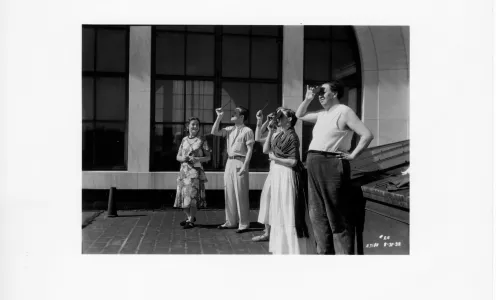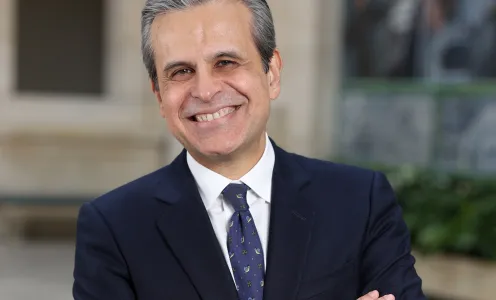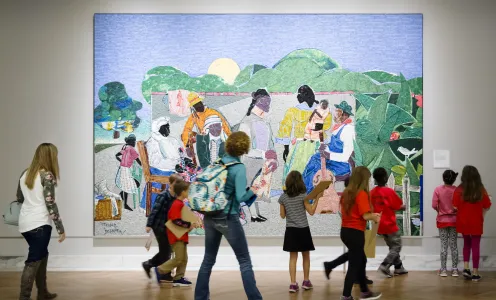Director’s Letter, October 2016
Updated Jul 20, 2022
Every time I leave my third-floor office and go down to the DIA galleries, I encounter a new adventure, a learning opportunity, a moment of delight, and an empathetic connection with others. Engaging with the collection and sharing it with our friends always brings new insights. During the last decade at the DIA, we have created experiences that help each visitor find personal meaning in art. In the upcoming years, we would like those moments of personal meaning to become shared experiences with others. The DIA team is very excited about this approach because sharing the museum experience gives it a deeper significance and is more meaningful for the participants. Furthermore, I also like to think that the more we share the more we have. At the DIA, we want you to feel ownership of the collection, be inspired by the art, and feel connected with others.
Let me tell you about one of my own personal experiences of sharing at the DIA. A couple of weeks ago I was wandering through the galleries with a friend, Mort Harris. Mort is a Detroiter and a WWII hero who flew B-17s (known as the flying fortress), completing thirty-three successful missions over Nazi-occupied Europe (An extraordinary accomplishment on its own but beyond that, during one of them, he "landed" on the North Sea-something he does not recommend). Together, we admired Diego Rivera's Detroit Industry frescos, and he pointed out to me the kind of planes that are painted on the west wall of the murals and how much it cost at the time to fly one. I thought it was pretty unbelievable that someone in 2016 could provide me such information based on his own direct experience.
We then continued into our late nineteenth-century galleries. We stopped in front of the portrait of Postman Roulin that Vincent van Gogh portrayed when he was working in Arles, in the south of France. I started to talk about Van Gogh, his revolutionary brushwork, his inspirational sense of color, his choice to paint Roulin many times, and other matters related to the history of art. My friend listened to me and said, "Ah! yes, Vincent van Gogh, this is the artist whose brother [Theo] financially supported him so he could paint." Mort's comment made me look at Van Gogh's art in a radically new light, a human one: Theo's generosity and love for his brother enabled Vincent's amazing works to exist today, allowing him to become perhaps the most famous artist in the world.
In the same generous vein of Theo van Gogh, the DIA has recently been blessed with the philanthropy of many corporations, foundations, and individuals who helped save our world- class collection throughout the city of Detroit's bankruptcy process. My friend, Mort Harris, was one of those extraordinary philanthropists. Thank you, Mort, for caring so much for our community and especially for sharing with me Theo's perspective of Vincent van Gogh's story. Our collection has gained a deeper and more profound meaning for me. I now make sure to quietly say "thank you Theo" every time I enjoy Van Gogh's inspirational colors and brave brushwork.
Every time I leave my third-floor office and go down to the DIA galleries, I encounter a new adventure, a learning opportunity, a moment of delight, and an empathetic connection with others. Engaging with the collection and sharing it with our friends always brings new insights. During the last decade at the DIA, we have created experiences that help each visitor find personal meaning in art. In the upcoming years, we would like those moments of personal meaning to become shared experiences with others. The DIA team is very excited about this approach because sharing the museum experience gives it a deeper significance and is more meaningful for the participants. Furthermore, I also like to think that the more we share the more we have. At the DIA, we want you to feel ownership of the collection, be inspired by the art, and feel connected with others.
Let me tell you about one of my own personal experiences of sharing at the DIA. A couple of weeks ago I was wandering through the galleries with a friend, Mort Harris. Mort is a Detroiter and a WWII hero who flew B-17s (known as the flying fortress), completing thirty-three successful missions over Nazi-occupied Europe (An extraordinary accomplishment on its own but beyond that, during one of them, he "landed" on the North Sea-something he does not recommend). Together, we admired Diego Rivera's Detroit Industry frescos, and he pointed out to me the kind of planes that are painted on the west wall of the murals and how much it cost at the time to fly one. I thought it was pretty unbelievable that someone in 2016 could provide me such information based on his own direct experience.
We then continued into our late nineteenth-century galleries. We stopped in front of the portrait of Postman Roulin that Vincent van Gogh portrayed when he was working in Arles, in the south of France. I started to talk about Van Gogh, his revolutionary brushwork, his inspirational sense of color, his choice to paint Roulin many times, and other matters related to the history of art. My friend listened to me and said, "Ah! yes, Vincent van Gogh, this is the artist whose brother [Theo] financially supported him so he could paint." Mort's comment made me look at Van Gogh's art in a radically new light, a human one: Theo's generosity and love for his brother enabled Vincent's amazing works to exist today, allowing him to become perhaps the most famous artist in the world.
In the same generous vein of Theo van Gogh, the DIA has recently been blessed with the philanthropy of many corporations, foundations, and individuals who helped save our world- class collection throughout the city of Detroit's bankruptcy process. My friend, Mort Harris, was one of those extraordinary philanthropists. Thank you, Mort, for caring so much for our community and especially for sharing with me Theo's perspective of Vincent van Gogh's story. Our collection has gained a deeper and more profound meaning for me. I now make sure to quietly say "thank you Theo" every time I enjoy Van Gogh's inspirational colors and brave brushwork.


